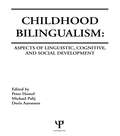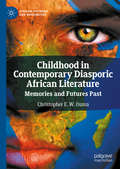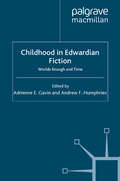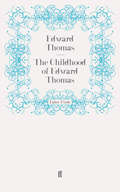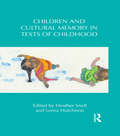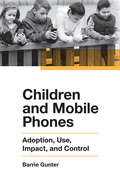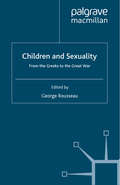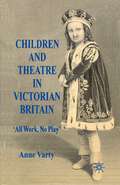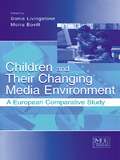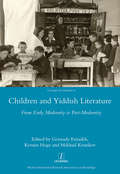- Table View
- List View
Childhood Bilingualism: Aspects of Linguistic, Cognitive, and Social Development
by Peter Homel Michael Palij Doris AaronsonFirst published in 1987. Routledge is an imprint of Taylor & Francis, an informa company.
Childhood Bilingualism: Aspects of Linguistic, Cognitive, and Social Development
by Peter Homel, Michael Palij and Doris AaronsonFirst published in 1987. Routledge is an imprint of Taylor & Francis, an informa company.
Childhood in Contemporary Diasporic African Literature: Memories and Futures Past (African Histories and Modernities)
by Christopher E. OumaThis book examines the representation of figures, memories and images of childhood in selected contemporary diasporic African fiction by Adichie, Abani, Wainaina and Oyeyemi. The book argues that childhood is a key framework for thinking about contemporary African and African Diasporic identities. It argues that through the privileging of childhood memory, alternative conceptions of time emerge in this literature, and which allow African writers to re-imagine what family, ethnicity, nation means within the new spaces of diaspora that a majority of them occupy. The book therefore looks at the connections between childhood, space, time and memory, childhood gender and sexuality, childhoods in contexts of war, as well as migrant childhoods. These dimensions of childhood particularly relate to the return of the memory of Biafra, the figures of child soldiers, memories of growing up in Cold War Africa, queer boyhoods/sonhood as well as experiences of migration within Africa, North America and Europe.
Childhood in Contemporary Performance of Shakespeare
by Gemma MillerChild characters feature more numerously and prominently in the Shakespearean canon than in that of any other early modern playwright. Focusing on stage and film productions from the past four decades, this study addresses how Shakespeare's child characters are reflected, refracted and reinterpreted in performance. By adopting an interdisciplinary approach that incorporates close reading, semiotics, childhood studies, queer theory and performance studies, Gemma Miller explores how a close analysis of Shakespeare's child characters, both in the text and in performance, can reveal often uncomfortable truths about contemporary ideas of childhood, as well as offer fresh insights into the plays.Among the works and productions analysed are stage productions of Richard III by Sean Holmes and Thomas Ostermeier; Jamie Lloyd's and Michael Boyd's stage productions of Macbeth and the films of Roman Polanski and Justin Kurzel; Deborah Warner's stage production of Titus Andronicus and filmed adaptations by Jane Howell and Julie Taymor; and stage productions of The Winter's Tale by Nicholas Hytner, and by Kenneth Branagh and Rob Ashford, and the ballet adaptation by Christopher Wheeldon.
Childhood in Contemporary Performance of Shakespeare
by Gemma MillerChild characters feature more numerously and prominently in the Shakespearean canon than in that of any other early modern playwright. Focusing on stage and film productions from the past four decades, this study addresses how Shakespeare's child characters are reflected, refracted and reinterpreted in performance. By adopting an interdisciplinary approach that incorporates close reading, semiotics, childhood studies, queer theory and performance studies, Gemma Miller explores how a close analysis of Shakespeare's child characters, both in the text and in performance, can reveal often uncomfortable truths about contemporary ideas of childhood, as well as offer fresh insights into the plays.Among the works and productions analysed are stage productions of Richard III by Sean Holmes and Thomas Ostermeier; Jamie Lloyd's and Michael Boyd's stage productions of Macbeth and the films of Roman Polanski and Justin Kurzel; Deborah Warner's stage production of Titus Andronicus and filmed adaptations by Jane Howell and Julie Taymor; and stage productions of The Winter's Tale by Nicholas Hytner, and by Kenneth Branagh and Rob Ashford, and the ballet adaptation by Christopher Wheeldon.
Childhood in Edwardian Fiction: Worlds Enough and Time
by A. Gavin A. HumphriesThe first book-length look at childhood in Edwardian fiction, this book challenges assumptions that the Edwardian period was simply a continuation of the Victorian or the start of the Modern. Exploring both classics and popular fiction, the authors provide a a compelling picture of the Edwardian fictional cult of childhood.
Childhood in the Contemporary English Novel (Studies in Childhood, 1700 to the Present)
by Sandra DinterSince the 1980s novels about childhood for adults have been a booming genre within the contemporary British literary market. Childhood in the Contemporary English Novel offers the first comprehensive study of this literary trend. Assembling analyses of key works by Ian McEwan, Doris Lessing, P. D. James, Nick Hornby, Sarah Moss and Stephen Kelman and situating them in their cultural and political contexts, Sandra Dinter uncovers both the reasons for the current popularity of such fiction and the theoretical shift that distinguishes it from earlier literary epochs. The book’s central argument is that the contemporary English novel draws on the constructivist paradigm shift that revolutionised the academic study of childhood several decades ago. Contemporary works of fiction, Dinter argues, depart from the notion of childhood as a naturally given phase of life and examine the agents, interests and conflicts involved in its cultural production. Dinter also considers the limits of this new theoretical impetus, observing that authors and scholars alike, even when they claim to conceive of childhood as a construct, do not always give up on the idea of its ‘natural’ core. Accordingly, this book reconstructs how the English novel between the 1980s and the 2010s oscillates between an acknowledgment of constructivism and an endorsement of childhood as the last irrevocable quintessence of humanity. In doing so, it successfully extends the literary and cultural history of childhood to the immediate present.
Childhood in the Contemporary English Novel (Studies in Childhood, 1700 to the Present)
by Sandra DinterSince the 1980s novels about childhood for adults have been a booming genre within the contemporary British literary market. Childhood in the Contemporary English Novel offers the first comprehensive study of this literary trend. Assembling analyses of key works by Ian McEwan, Doris Lessing, P. D. James, Nick Hornby, Sarah Moss and Stephen Kelman and situating them in their cultural and political contexts, Sandra Dinter uncovers both the reasons for the current popularity of such fiction and the theoretical shift that distinguishes it from earlier literary epochs. The book’s central argument is that the contemporary English novel draws on the constructivist paradigm shift that revolutionised the academic study of childhood several decades ago. Contemporary works of fiction, Dinter argues, depart from the notion of childhood as a naturally given phase of life and examine the agents, interests and conflicts involved in its cultural production. Dinter also considers the limits of this new theoretical impetus, observing that authors and scholars alike, even when they claim to conceive of childhood as a construct, do not always give up on the idea of its ‘natural’ core. Accordingly, this book reconstructs how the English novel between the 1980s and the 2010s oscillates between an acknowledgment of constructivism and an endorsement of childhood as the last irrevocable quintessence of humanity. In doing so, it successfully extends the literary and cultural history of childhood to the immediate present.
The Childhood of Edward Thomas
by Edward ThomasKilled at Arras in 1917, Edward Thomas left behind him a short, vivid history of his own early life, covering the period from his birth to his entry into St Paul's. Though a fragment, in many senses it is far more: in the words of its author 'no less than an autobiography . . . an attempt to put down on paper what [this author] sees when he thinks of himself from 1878 to about 1895'. The Childhood of Edward Thomas was not published until 1938, over two decades after Thomas originally showed the manuscript to a publisher. Those eventual publishers, Faber & Faber, were building on their release two years earlier of Thomas's Collected Poems, for which he was becoming best known.This edition includes Edward Thomas's 'War Diary,' a record of the last three months of his life when, as an elderly - at thirty-eight - subaltern he fought among the misery of the trenches. To witness Thomas's childhood memoir and wartime diaries in such close proximity is to have a moving incarnation of his distinctive voice, its clarity and - even in war - its unfailing attention to his fellow-creatures.
Childhood Traumas: Narratives and Representations
by Kamayani Kumar; Angelie MultaniThis volume contributes to understanding childhoods in the twentieth and twenty-firstcentury by offering an in-depth overview of children and their engagement with the violent world around them. The chapters deal with different historical, spatial, and cultural contexts, yet converge on the question of how children relate to physiological and psychological violence. The twentieth century has been hailed as the "century of the child" but it has also witnessed an unprecedented escalation of cultural trauma experienced by children during the two World Wars, Holocaust, Partition of the Indian subcontinent, and Vietnam War. The essays in this volume focus on victimized childhood during instances of war, ethnic violence, migration under compulsion, rape, and provide insights into how a child negotiates with abstract notions of nation, ethnicity, belonging, identity, and religion. They use an array of literary and cinematic representations—fiction, paintings, films, and popular culture—to explore the long-term effect of violence and neglect on children. As such, they lend voice to children whose experiences of abuse have been multifaceted, ranging from genocide, conflict and xenophobia to sexual abuse, and also consider ways of healing. With contributions from across the world, this comprehensive book will be useful to scholars and researchers of cultural studies, literature, education, education policy, gender studies, child psychology, sociology, political studies, childhood studies, and those studying trauma, conflict, and resilience.
Childhood Traumas: Narratives and Representations
by Kamayani Kumar Angelie MultaniThis volume contributes to understanding childhoods in the twentieth and twenty-firstcentury by offering an in-depth overview of children and their engagement with the violent world around them. The chapters deal with different historical, spatial, and cultural contexts, yet converge on the question of how children relate to physiological and psychological violence. The twentieth century has been hailed as the "century of the child" but it has also witnessed an unprecedented escalation of cultural trauma experienced by children during the two World Wars, Holocaust, Partition of the Indian subcontinent, and Vietnam War. The essays in this volume focus on victimized childhood during instances of war, ethnic violence, migration under compulsion, rape, and provide insights into how a child negotiates with abstract notions of nation, ethnicity, belonging, identity, and religion. They use an array of literary and cinematic representations—fiction, paintings, films, and popular culture—to explore the long-term effect of violence and neglect on children. As such, they lend voice to children whose experiences of abuse have been multifaceted, ranging from genocide, conflict and xenophobia to sexual abuse, and also consider ways of healing. With contributions from across the world, this comprehensive book will be useful to scholars and researchers of cultural studies, literature, education, education policy, gender studies, child psychology, sociology, political studies, childhood studies, and those studying trauma, conflict, and resilience.
Childly Language: Children, language and the social world (Real Language Series)
by Alison SealeyChildly Language explores how attitudes and cultural assumptions about children and childhood are revealed in contemporary English. It addresses such questions as: How is concern for children's safety and welfare reflected in the vocabulary and grammar of contemporary English? and When we say that an adult is being 'childish', what are we saying about the characteristics of children?
Childly Language: Children, language and the social world (Real Language Series)
by Alison SealeyChildly Language explores how attitudes and cultural assumptions about children and childhood are revealed in contemporary English. It addresses such questions as: How is concern for children's safety and welfare reflected in the vocabulary and grammar of contemporary English? and When we say that an adult is being 'childish', what are we saying about the characteristics of children?
Children and Biography: Reading and Writing Life Stories (New Directions in Life Narrative)
by Kate DouglasThe first study of life narratives produced for, about, and written by children, this book examines the recent popularity of children's biographies and how they engage with the biggest issues of our time: environmental change, health crises, education, and children's personal and political development. Beginning with a literary-historical overview, Children and Biography proceeds to examine 21st-century examples and trends such as illustrated texts including Women in Science, the Fantastically Great Women Who… books, Rebel Dogs, Goodnight Stories for Rebel Girls, Kids Who Did, My Beautiful Birds and The Journey. The book also considers archives of children's writings and drawings, in particular the testimonies of child asylum seekers, children's biographical art, and 'Lockdown diaries' produced during the Covid-19 pandemic. By analyzing these works alongside empirical studies into how such material is received by child readers, and how texts generated by children are perceived both by them and their parents, this book provides new knowledge on how biographies for children are produced and read. Comprehensive and original, Children and Biography, presents an ethical methodological framework for scholarly practice when reading, witnessing and interpreting children's life narratives. The book offers a mandate for future researchers: to place children's voices and writing at the centre of inquiries in ways that facilitate genuine agency for child authors.
Children and Biography: Reading and Writing Life Stories (New Directions in Life Narrative)
by Kate DouglasThe first study of life narratives produced for, about, and written by children, this book examines the recent popularity of children's biographies and how they engage with the biggest issues of our time: environmental change, health crises, education, and children's personal and political development. Beginning with a literary-historical overview, Children and Biography proceeds to examine 21st-century examples and trends such as illustrated texts including Women in Science, the Fantastically Great Women Who… books, Rebel Dogs, Goodnight Stories for Rebel Girls, Kids Who Did, My Beautiful Birds and The Journey. The book also considers archives of children's writings and drawings, in particular the testimonies of child asylum seekers, children's biographical art, and 'Lockdown diaries' produced during the Covid-19 pandemic. By analyzing these works alongside empirical studies into how such material is received by child readers, and how texts generated by children are perceived both by them and their parents, this book provides new knowledge on how biographies for children are produced and read. Comprehensive and original, Children and Biography, presents an ethical methodological framework for scholarly practice when reading, witnessing and interpreting children's life narratives. The book offers a mandate for future researchers: to place children's voices and writing at the centre of inquiries in ways that facilitate genuine agency for child authors.
Children and Cultural Memory in Texts of Childhood (Children's Literature and Culture)
by Heather Snell Lorna HutchisonThe essays in this collection address the relationship between children and cultural memory in texts both for and about young people. The collection overall is concerned with how cultural memory is shaped, contested, forgotten, recovered, and (re)circulated, sometimes in opposition to dominant national narratives, and often for the benefit of young readers who are assumed not to possess any prior cultural memory. From the innovative development of school libraries in the 1920s to the role of utopianism in fixing cultural memory for teen readers, it provides a critical look into children and ideologies of childhood as they are represented in a broad spectrum of texts, including film, poetry, literature, and architecture from Canada, the United States, Japan, Germany, Britain, India, and Spain. These cultural forms collaborate to shape ideas and values, in turn contributing to dominant discourses about national and global citizenship. The essays included in the collection imply that childhood is an oft-imagined idealist construction based in large part on participation, identity, and perception; childhood is invisible and tangible, exciting and intriguing, and at times elusive even as cultural and literary artifacts recreate it. Children and Cultural Memory in Texts of Childhood is a valuable resource for scholars of children’s literature and culture, readers interested in childhood and ideology, and those working in the fields of diaspora and postcolonial studies.
Children and Cultural Memory in Texts of Childhood: Children And Cultural Memory In Texts Of Childhood (Children's Literature and Culture)
by Heather Snell Lorna HutchisonThe essays in this collection address the relationship between children and cultural memory in texts both for and about young people. The collection overall is concerned with how cultural memory is shaped, contested, forgotten, recovered, and (re)circulated, sometimes in opposition to dominant national narratives, and often for the benefit of young readers who are assumed not to possess any prior cultural memory. From the innovative development of school libraries in the 1920s to the role of utopianism in fixing cultural memory for teen readers, it provides a critical look into children and ideologies of childhood as they are represented in a broad spectrum of texts, including film, poetry, literature, and architecture from Canada, the United States, Japan, Germany, Britain, India, and Spain. These cultural forms collaborate to shape ideas and values, in turn contributing to dominant discourses about national and global citizenship. The essays included in the collection imply that childhood is an oft-imagined idealist construction based in large part on participation, identity, and perception; childhood is invisible and tangible, exciting and intriguing, and at times elusive even as cultural and literary artifacts recreate it. Children and Cultural Memory in Texts of Childhood is a valuable resource for scholars of children’s literature and culture, readers interested in childhood and ideology, and those working in the fields of diaspora and postcolonial studies.
Children and Mobile Phones: Adoption, Use, Impact, and Control
by Barrie GunterThis book provides a resource for readers interested in the issues surrounding mobile phone use by children. Mobile phones are ubiquitous in young people’s lives around the world. Most teenagers and many pre-teenage children have their own mobile phone and carry it around everywhere they go. While the mobile phone remains an important communication device for making and receiving voice calls, technological advances have evolved the typical device far beyond simple functionality. Recent models are multi-functional mini-computers with ever-increasing power that enable users to communicate through a range of channels and to engage in multiple other activities. For many young people, life without their mobile phone is unimaginable, but mobile phones can be a source of risk and threat. Understanding how they are used and highlighting potential dangers is an essential activity to enable the creation of sensible and acceptable strategies to ensure that benefits are maximised and risks are minimised. Stakeholders such as parents, industry, regulators, government and children themselves all have vested interests in how children use mobile phones and bear some responsibility for young mobile users.
Children and Mobile Phones: Adoption, Use, Impact, and Control
by Barrie GunterThis book provides a resource for readers interested in the issues surrounding mobile phone use by children. Mobile phones are ubiquitous in young people’s lives around the world. Most teenagers and many pre-teenage children have their own mobile phone and carry it around everywhere they go. While the mobile phone remains an important communication device for making and receiving voice calls, technological advances have evolved the typical device far beyond simple functionality. Recent models are multi-functional mini-computers with ever-increasing power that enable users to communicate through a range of channels and to engage in multiple other activities. For many young people, life without their mobile phone is unimaginable, but mobile phones can be a source of risk and threat. Understanding how they are used and highlighting potential dangers is an essential activity to enable the creation of sensible and acceptable strategies to ensure that benefits are maximised and risks are minimised. Stakeholders such as parents, industry, regulators, government and children themselves all have vested interests in how children use mobile phones and bear some responsibility for young mobile users.
Children and Sexuality: From the Greeks to the Great War (Palgrave Studies in the History of Childhood)
by G. RousseauChildren and Sexuality probes the hidden relations between children and sexuality in case studies from the Greeks to the Great War. The lives reconstructed here extend from Greek Alcibiades to Lewis Carroll and Baden-Powell, each recounted with scrupulous vigilance to detail and nuance.
Children and Theatre in Victorian Britain
by A. VartyThe cult of the child performer was a significant emergence of the Victorian age. Fierce public debate and lasting legislation grew out of the conflict between a desire for juvenile display and a determination to stop exploitation. This study explores the social and artistic context of their lives and their developing professionalism as actors.
Children and Their Changing Media Environment: A European Comparative Study (Routledge Communication Series)
by Sonia Livingstone Moira BovillFocusing on the meanings, uses, and impacts of new media in childhood, family life, peer culture, and the relation between home and school, this volume sets out to address many of the questions, fears, and hopes regarding the changing place of media in the lives of today's children and young people. The scholars contributing to this work argue that such questions--intellectual, empirical, and policy-related--can be productively addressed through cross-national research. Hence, this volume brings together researchers from 12 countries--Belgium, Denmark, Finland, France, Germany, the United Kingdom, Israel, Italy, the Netherlands, Spain, Sweden, and Switzerland--to present original and comprehensive findings regarding the diffusion and significance of new media and information technologies among children. Inspired by parallels and difference between the arrival of television in the family home during the 1950s and the present day arrival of new media, the research is based on in-depth interviews and a detailed comparative survey of 6- to 16-year-olds across Europe and in Israel. The result is a comprehensive, detailed, and fascinating account of how these technologies are rapidly becoming central to the daily lives of young people. As a resource for researchers and students in media and communication studies, leisure and cultural studies, social psychology, and related areas, this volume provides crucial insights into the role of media in the lives of children. The findings included herein will also be of interest to policymakers in broadcasting, technology, and education throughout the world.
Children and Their Changing Media Environment: A European Comparative Study (Routledge Communication Series)
by Sonia Livingstone Moira BovillFocusing on the meanings, uses, and impacts of new media in childhood, family life, peer culture, and the relation between home and school, this volume sets out to address many of the questions, fears, and hopes regarding the changing place of media in the lives of today's children and young people. The scholars contributing to this work argue that such questions--intellectual, empirical, and policy-related--can be productively addressed through cross-national research. Hence, this volume brings together researchers from 12 countries--Belgium, Denmark, Finland, France, Germany, the United Kingdom, Israel, Italy, the Netherlands, Spain, Sweden, and Switzerland--to present original and comprehensive findings regarding the diffusion and significance of new media and information technologies among children. Inspired by parallels and difference between the arrival of television in the family home during the 1950s and the present day arrival of new media, the research is based on in-depth interviews and a detailed comparative survey of 6- to 16-year-olds across Europe and in Israel. The result is a comprehensive, detailed, and fascinating account of how these technologies are rapidly becoming central to the daily lives of young people. As a resource for researchers and students in media and communication studies, leisure and cultural studies, social psychology, and related areas, this volume provides crucial insights into the role of media in the lives of children. The findings included herein will also be of interest to policymakers in broadcasting, technology, and education throughout the world.
Children and Yiddish Literature From Early Modernity to Post-Modernity
by Gennady Estraikh Kerstin Hoge Krutikov MikhailChildren have occupied a prominent place in Yiddish literature since early modern times, but children’s literature as a genre has its beginnings in the early 20th century. Its emergence reflected the desire of Jewish intellectuals to introduce modern forms of education, and promote ideological agendas, both in Eastern Europe and in immigrant communities elsewhere. Before the Second World War, a number of publishing houses and periodicals in Europe and the Americas specialized in stories, novels and poems for various age groups. Prominent authors such as Yankev Glatshteyn, Der Nister, Joseph Opatoshu, Leyb Kvitko, made original contributions to the genre, while artists, such as Marc Chagall, El Lissitzky and Yisakhar Ber Rybak, also took an active part. In the Soviet Union, meanwhile, children’s literature provided an opportunity to escape strong ideological pressure. Yiddish children’s literature is still being produced today, both for secular and strongly Orthodox communities. This volume is a pioneering collective study not only of children’s literature but of the role played by children in literature.
Children and Yiddish Literature From Early Modernity to Post-Modernity: From Early Modernity To Post-modernity (Legenda Ser.)
by Gennady Estraikh Kerstin Hoge Krutikov MikhailChildren have occupied a prominent place in Yiddish literature since early modern times, but children’s literature as a genre has its beginnings in the early 20th century. Its emergence reflected the desire of Jewish intellectuals to introduce modern forms of education, and promote ideological agendas, both in Eastern Europe and in immigrant communities elsewhere. Before the Second World War, a number of publishing houses and periodicals in Europe and the Americas specialized in stories, novels and poems for various age groups. Prominent authors such as Yankev Glatshteyn, Der Nister, Joseph Opatoshu, Leyb Kvitko, made original contributions to the genre, while artists, such as Marc Chagall, El Lissitzky and Yisakhar Ber Rybak, also took an active part. In the Soviet Union, meanwhile, children’s literature provided an opportunity to escape strong ideological pressure. Yiddish children’s literature is still being produced today, both for secular and strongly Orthodox communities. This volume is a pioneering collective study not only of children’s literature but of the role played by children in literature.
